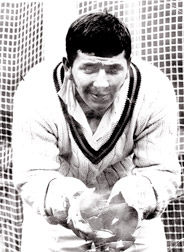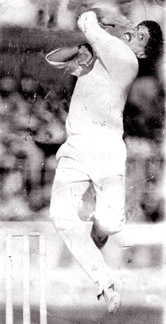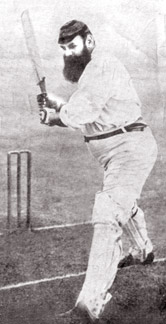Lest we forget... what the cricketing stars did....
By A.C. De Silva
FLASHBACK: The game of cricket has many interesting stories connected
to it and that's one of the reasons why so many people are attracted to
the game. There are some interesting anecdotes that keeps one glued to
the game and also has the general public interested.
There are many forms of a batsman getting out and one of the common
forms is getting bowled.
|

Rodney Marsh the most dismissals by a wicket-keeper in
Test cricket 355 who between November 27 in 1970 and
January 6 held a record 343 catches and made 12 stumpings in
196 matches for Australia. Marsh gained the record on 18th
July 1981. He also holds the record of taking most catches
off one bowler 95 off West Australian bowler Dennis
Lillee. |
The longest recorded distance for a bail to travel from the stumps
after a batsman has been bowled takes interesting reading. Getting
bowled is where the ball hits the wickets and thereby the batsman has
got marching orders to leave the field.
It is interesting to note that the longest recorded distance for a
bail to travel from the stumps after a batsman has been bowled is 67
yards 6 inches. This record occurred at Old Trafford, Manchester, on
29th June 1911 when Robert Burrows of Worcestershire bowled William
Huddleston of Lancashire and one of the bails flew as far as the
boundary.
In the game of cricket a much appreciable player is the allrounder
and the most stunning performance of a cricketer to score a century and
take all ten wickets in an innings in a first-class match in Britain
since 1869... is W.G. Grace.
Playing for the MCC against Oxford University at Oxford Parks on June
21 and 22 in 1886, "The champion" scored 104 in his only innings, before
taking all ten Oxford second innings wickets for 49 runs in 36.2
four-ball overs.
The longest match
Cricket has branched out to many forms. There are Test matches of
five days duration these days - that's the normal form in the present
day set-up, but in the years gone by Test matches have gone on for the
sixth day. The longest match in England in terms of hours of play is the
drawn six-day Fourth Test between England and Australia at The Oval in
1975.
Actual playing time, excluding 187 minutes lost and breaks between
innings, totalled 32 hours 17 minutes. Two other six-day matches have
been staged in England, both Test matches against Australia at The Oval.
In 1930, Australia won at 3.50 p.m. on the last day after rain had
prevented play on the penultimate one - 42 years later Australia
repeated their victory at 2,49 p.m. on the sixth day.
Lowest innings total 26
The lowest innings total in Test cricket is 26 by New Zealand at Eden
Park, Auckland on 28th March 1955. Playing the second of two Tests
against Hutton's England team which had just retained the Ashes in
Australia, New Zealand had contained the tourists to a first innings
lead of 46.
A crowd of 14,000 saw the home side reduced to 14 for 5 and
eventually dismissed in 27 overs by Tyson (2 for 10), Statham (3 for 9),
Appleyard (4 for 7) and Wardle (1 for 0).
|

Kapil Dev the youngest bowler to take 200 wickets. He was
24 years and 68 days when he took his 50th Test wicket too.
He performed the double against West Indies at Port-of-
|

Dr. W.G. Grace was the champion cricketer of those early
days. The highest number of wickets to fall on a single day
was 27 on 17th July 1888. The wicket of Dr. W.G. Grace the
champion cricketer of the day, figured twice in that
incredible tally and he batted on a difficult mud pitch at
Lords on the second day of the First Test against
Australia. Grace the only England batsman to reach double
figures in both innings recorded the highest score of the
match: 24. In just over 3 hours of actual play, 27 wickets
had fallen for 157 runs. In the early days Dr. Grace playing
for MCC in 1886 made 104 and bagged 10 wickets in 1886 vs
Oxford University. |
Opening batsman Bert Sutcliffe (11) achieved the only double-figure
score of an innings which lasted 106 minutes either side of the tea
interval on the third day.
Appleyard took 3 wickets in four balls and narrowly missed the
hat-trick. It was Hutton's last Test.
Lowest declared total
In cricket, be it Test matches or otherwise,the accepted norm is to
make a declaration when the side batting is in a favourable position.
However, this doesn't seem to have been followed in the good old days.
In 1950 Australia declared their first innings at an unbelievable score
of 32 for 7 wickets at Woolloonagabba, Brisbane on 4th December 1950.
Caught on a 'sticky' wicket, Australia declared their innings when only
192 runs ahead, took 6 England second innings wickets for 30 runs before
the close, and went on to win by 70 runs.
Generally in cricket, Test matches to speak of, the trend is to hit
up a sizeable score when batting first.
This is usually done with victory foremost in he mind of the side
batting first. England achieved this at the Oval on August 24 in 1938
when they defeated Australia by an innings and 579 runs on the fourth
day.
After amassing the record total then of 903 for 7 wickets in 15 hours
17 minutes when Hammond declared at tea on the third day.
England dismissed Australia twice in 4 and 3/4 hours of play. With
Fingleton and Donald Bradman both injured and unable to bat, Australia
were out for 201 and 123.
An Asian had come into the cricket scene and it is from India that
the news has come that Kapil Dev playing his 50th Test celebrated the
occasion in grand style by completing the double - 200 wickets at the
relatively young age of 24 years and 68 days on March 15 in 1983 playing
in his 50th Test match against the West Indies at Port of Spain. Then
going over to England, there was England's Fred Trueman who became the
first bowler to collect 300 Test wickets. He reached that impressive
haul at The Oval in his 65th Test on 15th August 1964 when he had Neil
Hawke of Australia caught at slip by Colin Cowdrey.
Marsh- the leading wicket-keeper
There has been a lot said about batsmen and bowlers, and it is
nothing but right we also consider the wicket-keepers who have done
yeomen service behind the stumps.
The most dismissals by a wicket-keeper in Test cricket is 355 by
Rodney Marsh, who between 27th November 1970 and January 6th 1984, held
a record 343 catches and made 12 stumpings in 96 matches for Australia.
Marsh gained the record on 18th July 1981 when he caught Botham in
England's first innings of the Third Test at Headingley, Leeds to
overtake Alan Knott's total of 263 dismissals. Although Knott recalled
for the last two Tests of that series and held six more catches he was
unable to regain the record.Marsh also holds the record for taking most
catches off one bowler - 95 of his victims being caught off his fellow
West Australian Dennis Lillee. |


